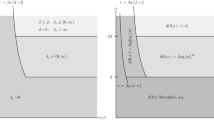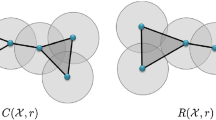Abstract
We develop a cluster expansion for the probability of full connectivity of high density random networks in confined geometries. In contrast to percolation phenomena at lower densities, boundary effects, which have previously been largely neglected, are not only relevant but dominant. We derive general analytical formulas that show a persistence of universality in a different form to percolation theory, and provide numerical confirmation. We also demonstrate the simplicity of our approach in three simple but instructive examples and discuss the practical benefits of its application to different models.








Similar content being viewed by others
Notes
If the convexity assumption is relaxed it is a semi-metric function, i.e. the triangle inequality may not be satisfied. For example, r ij is effectively infinite if there is an obstacle blocking the path of a wireless signal, but adding a node k that avoids the obstacle may permit indirect connection between i and j, thus in this case r ij >r ik +r kj . We defer the treatment of obstacles to a future paper.
Other link models can also be considered. These may include single-input multiple-output (SIMO), multiple-input single-output (MISO), and multiple-input multiple-output (MIMO) (see also [39]).
Typically η=2 corresponds to propagation in free space but for practical reasons it is often modeled as η>2 for cluttered environments.
This was taken from a standard Rayleigh fading link model (also see [39]).
References
Bollobás, B., Riordan, O.: Percolation. Cambridge University Press, Cambridge (2006)
Broadbent, S.R., Hammersley, J.M.: Percolation processes. Proc. Camb. Philol. Soc. 5, 629 (1957)
Erdős, P., Rényi, A.: On random graphs I. Publ. Math. (Debr.) 6, 290 (1959)
Bollobás, B.: Random Graphs. Cambridge University Press, Cambridge (2001)
Coniglio, A., Angelis, U.De., Forlani, A.: Pair connectedness and cluster size. J. Phys. A, Math. Gen. 10, 1123 (1977)
Stell, G.: Continuum theory of percolation. J. Phys., Condens. Matter 8, A1 (1996)
Hill, T.L.: Statistical Mechanics. McGraw-Hill, New York (1956)
DeSimone, T., Demoulini, S., Stratt, R.M.: A theory of percolation in liquids. J. Chem. Phys. 85, 391 (1986)
Hill, T.L.: Molecular clusters in imperfect gases. J. Chem. Phys. 23, 617 (1955)
Chiew, Y., Glandt, E.: Percolation behaviour of permeable and of adhesive spheres. J. Phys. A, Math. Gen. 16, 2599 (1983)
Safran, S.A., Webman, I., Grest, G.S.: Percolation in interacting colloids. Phys. Rev. A 32, 506 (1985)
Hu, L., Hecht, D.S., Grüner, G.: Percolation in transparent and conducting carbon nanotube networks. Nano Lett. 4(12), 2513 (2004)
Toker, D., Azulay, D., Shimoni, N., Balberg, I., Millo, O.: Tunneling and percolation in metal-insulator composite materials. Phys. Rev. B 68, 041403(R) (2003)
Lee, D.-H., Wang, Z., Kivelson, S.: Quantum percolation and plateau transitions in the quantum hall effect. Phys. Rev. Lett. 70, 4130 (1993)
Kaminski, A., Das Sarma, S.: Polaron percolation in diluted magnetic semiconductors. Phys. Rev. Lett. 88, 247202 (2002)
Kim, J., Krapivsky, P.L., Kahng, B., Redner, S.: Infinite-order percolation and giant fluctuations in a protein interaction network. Phys. Rev. E 66, 055101(R) (2002)
Drossel, B., Schwabl, F.: Self-organized critical forest-fire model. Phys. Rev. Lett. 69, 1629 (1992)
Pueyo, S., de Alencastro Graca, P.M.L., Barbosa, R.I., Cots, R., Cardona, E., Fearnside, P.M.: Testing for criticality in ecosystem dynamics: the case of amazonian rainforest and savanna fire. Ecol. Lett. 13, 793 (2010)
Moore, C., Newman, M.E.J.: Epidemics and percolation in small-world networks. Phys. Rev. E 61, 5678 (2000)
Miller, J.C.: Spread of infectious disease through clustered populations. J. R. Soc. Interface 6, 1121 (2009)
Danon, L., et al.: Networks and the epidemiology of infectious disease. Interdisc. Persp. Infect. Diseases 2011, 284909 (2011)
Cohen, R., Havlin, S., ben-Avraham, D.: Efficient immunization strategies for computer networks and populations. Phys. Rev. Lett. 91, 247901 (2003)
Wang, P., González, M.C., Hidalgo, C.A., Barabási, A.L.: Understanding the spreading patterns of mobile phone viruses. Science 324, 1071 (2009)
Duffie, D., Manso, G.: Information percolation in large markets. Am. Econ. Rev. 97, 203 (2007)
Palla, G., Derényi, I., Farkas, I., Vicsek, T.: Uncovering the overlapping community structure of complex networks in nature and society. Nature 435, 814 (2005)
Palla, G., Barabási, A.-L., Vicsek, T.: Quantifying social group evolution. Nature 446, 664 (2007)
Parshani, R., Buldyrev, S., Havlin, S.: Critical effect of dependency groups on the function of networks. Proc. Natl. Acad. Sci. 108, 1007 (2011)
Penrose, M.: Random Geometric Graphs. Oxford University Press, London (2003)
Glauche, I., Krause, W., Sollacher, R., Greiner, M.: Continuum percolation of wireless ad hoc communication networks. Physica A 325, 577 (2003)
Paschos, G., Mannersalo, P., Stanczak, S.: Extending the percolation threshold using power control. In: IEEE WCNC, 1 (2009)
Callaway, D., Newman, M., Strogatz, S., Watts, D.: Network robustness and fragility: percolation on random graphs. Phys. Rev. Lett. 85, 5468 (2000)
Li, J., Andrew, L., Foh, C., Zukerman, M., Chen, H.: Connectivity, coverage and placement in wireless sensor networks. Sensors 9, 7664 (2009)
Ammari, H., Das, S.: Critical density for coverage and connectivity in three-dimensional wireless sensor networks using continuum percolation. IEEE Trans. Parallel Distrib. Syst. 20, 872 (2008)
Franceschetti, M., Dousse, O., Tse, D., Thiran, P.: Closing the gap in the capacity of wireless networks via percolation theory. IEEE Trans. Inf. Theory 53, 1009 (2007)
Mao, G., Anderson, B.: Towards a better understanding of large scale network models. IEEE/ACM Trans. Netw. 20, 408 (2012)
Penrose, M.: On k-connectivity for a geometric random graph. Random Struct. Algorithms 15(2), 145–164 (1999)
Coon, J.P., Dettmann, C.P., Georgiou, O.: Impact of boundaries on fully connected random geometric networks. Phys. Rev. E 85, 011138 (2012)
Tse, D., Viswanath, P.: Fundamentals of Wireless Communication. Cambridge University Press, Cambridge (2005)
Coon, J.P., Dettmann, C.P., Georgiou, O.: Connectivity of confined dense networks: boundary effects and scaling laws. Preprint. arXiv:1201.4013 (2012)
Haenggi, M., Andrews, J.G., Baccelli, F., Dousse, O., Franceschetti, M.: Stochastic geometry and random graphs for the design of wireless networks. IEEE J. Sel. Areas Commun. 27, 1029 (2009)
Kac, M.: Can one hear the shape of a drum? Am. Math. Mon. 73, 1 (1966)
Kyrylyuk, A., et al.: Controlling electrical percolation in multicomponent carbon nanotube dispersions. Nat. Nanotechnol. 6, 364 (2011)
Acknowledgements
The authors would like to thank the directors of the Toshiba Telecommunications Research Laboratory for their support.
Author information
Authors and Affiliations
Corresponding author
Rights and permissions
About this article
Cite this article
Coon, J., Dettmann, C.P. & Georgiou, O. Full Connectivity: Corners, Edges and Faces. J Stat Phys 147, 758–778 (2012). https://doi.org/10.1007/s10955-012-0493-y
Received:
Accepted:
Published:
Issue Date:
DOI: https://doi.org/10.1007/s10955-012-0493-y




